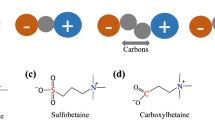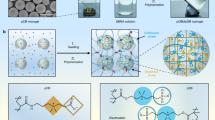Summary
By the selection of the relevant sources it is attempted to present the contemporary research situation of the hydrophilic polymeric gels as promising materials for the contact with the blood in the organism.
The reaction conditions of the current syntheses are described as well as the mutual interactions of the blood and the contact surface.
Zusammenfassung
Es wurden die wichtigsten Arbeiten über hydrophile Gele ausgewählt und im Hinblick auf ihre Eignung als aussichtsreiche Blut-Kontaktmaterialien betrachtet.
Die Reaktionsbedingungen werden beschrieben, und die gegenseitige Wechselwirkung von Blut und Kunststoff wird dargestellt.
Similar content being viewed by others
Literatur
Andrade, J. D., Kunimoto, K., van Wagenen, R., Kastigio, B., Gough, D., Kolff, W. J.: Coated adsorbents for direct blood perfusion: HEMA/activated carbon. Trans. Amer. Sec. artif. intern. Org.17, 222–228 (1971)
Andrade, J. D., Lee, H. B., Ihou, M. S., Kim, S. W., Hibbs, J. B., Jr.: Water as a biomaterial. Trans. Amer. Sec. artif. intern. Org.19, 1–7 (1973)
Barvič, M.: Tolerance of modified poly (glycol methacrylates) by the organism. J. biomed. Mater. Res.5, 225–227 (1971)
Barvič, M., Kliment, K., Zavadil, M.: Biologic properties and possible uses of polymer-like sponges. J. biomed. Mater. Res.1, 313–318 (1967)
Bikales, N. M.: Acrylamide and related amides. In: Leonard, E. C. (Ed.):Vinyl and diene monomers, Part I, pp81–104. New York-London-SydneyToronto; Wiley-Interscience 1970
Bloch, R.: Pers. Mitteilung
Brauer, G. M., Termini, D. J.: Grafting of acrylates and vinyl chains onto collagen with eerie initiator. J. appl. Polymer Sci.17, 2557–2561 (1973)
Byck, J. S., Gonsior, L. J., Gaasch, J. F.: Blood compatible polyelectrolytes. Bericht Nr. PB 211790 National Institutes of Health, USA, 1972
Costello, M., Stanczewski, B., Wiesman, P., Lucas, T., Srinivasan, S., Sawyer, P. N.: Correlations between electrochemical and antithrombogenic characteristics of polyelectrolyte materials. Trans. Amer. Sec. artif. intern. Org.16, 1–6 (1970)
Gott, V. L., Baier, R. E.: Evaluation of materials by vena cava rings in dogs (Vol. I). Jahresbericht Nr. PB 213109 National Institutes of Health. USA, 1972
Gott, V. L., Baier, R. E.: Evaluation of materials by vena cava rings in dogs (Vol. II), Jahresbericht Nr. PB 213110 National Institutes of Health, USA, 1972
Halpern, B. D., Blessing, H. W.: Polymer studies related to prosthetic cardiac materials which are non-clotting at a blood interface. Jahresbericht Nr. PB 215886 National Institutes of Health USA, 1973
Halpern, B. D., Cheng, H., Kuo, S., Greenberg, H.: Hydrogels as non-thrombogenic surfaces. Artificial Heart Program Conference Proceedings,1969, 87–96
Hoffman, A. S., Schmer, G., Harris, C., Kraft, W. G.: Covalent binding of biomolecules to radiation-grafted hydrogell on inert polymer surfaces. Trans. Amer. Sec. artif. intern. Org.18, 10–16 (1972)
Leininger, R. I.: Polymers as surgical implants. CRC Critical Reviews in Bioengineering1, 333–381 (1972)
Levowitz, B. S., La Guerre, J. N., Calem, W. S., Gould, F. E., Scherrer, J., Schoenfeld, H.: Biologic compatibility and applications of hydron. Trans. Amer. Sec. artif. intern. Org.14, 82–87 (1968)
Lyman, D. J.: Biomedical polymers: Their problems and promise. In: Bement, A. L., Jr.: Biomaterials-bioengineering applied to materials for hard and soft tissue replacement, pp269–276. Seattle-London: Univ. of Washington Press 1971
Marshall, D. W.: Development of polyelectrolyte complexes as thromboresistant materials for use in components of artificial hearts. Bericht Nr. PB 198403 National Institutes of Health USA, 1971
Pennington, C. J., Peterson, L. L., Rotaru, J. H., Boatman, J. B.: Biological evaluation of prosthetic materials: III. In vitro evaluation of cardiovascular prosthetic devices. Jahresbericht Nr. PB 201435 National Institutes of Health, USA, 1971
Refojo, M. F.: Polymers in ophthalmic surgery. J. biomed. Mater. Res.5, 113–117 (1971)
Scott, H., Kronick, P. L., Hillman, E. E.: Active-vapor grafting of hydrogels in medical prosthesis. Jahresbericht Nr. PB 206499 National Institutes of Health, USA, 1971
Schubert, R. J., Cupples, A. L.: Selection, characterisation, and biodegradation of surgical epoxies. In: Rembaum, A., Shen, M.: Biomedical polymers, pp.8799. New York: Marcel Dekker, Inc. 1971
Wichterle, O., Lim, D.: Hydrophilic gels for biological use. Nature (Lond.)185, 117–118 (1960); (US Patent 2976576 vom 28. Mdrz 1961)
Author information
Authors and Affiliations
Rights and permissions
About this article
Cite this article
Berger, J., Bücherl, E.S. Die hydrophilen Gele als Blut-Kontaktmaterialien. Langenbecks Arch Chiv 335, 263–272 (1974). https://doi.org/10.1007/BF01251641
Received:
Issue Date:
DOI: https://doi.org/10.1007/BF01251641




